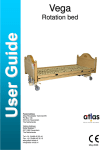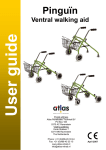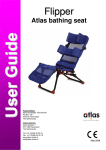Download Standing frame - Atlas
Transcript
Atlas Standing frame Postal address Atlas Revalidatie Techniek BV PO Box 106 5370 AC Ravenstein The Netherlands Visiting address Korte Stukken 7 5371 MN Ravenstein The Netherlands Tel: +31 (0)486-45 33 44 Fax: +31 (0)486-45 35 15 www.atlas-rehab.nl [email protected] April 2007 Atlas User Guide Foreword Foreword This user guide is intended for parents and/or supervisors of people who use the Atlas standing frame. The Atlas bears the CE marking, which indicates that it meets European safety requirements. The settings of the Atlas are adjusted by the dealer prior to delivery. This user guide subsequently helps you to make the most important adjustments to the Atlas, thus enabling the user to make optimal use of it. The user guide contains a great many photographs that will facilitate finding the adjustment facilities on the standing frame. Your experiences with the Atlas are important for its continual improvement. If you have remarks or suggestions for improvement of this product, please contact us via: Postal address: Atlas Revalidatie Techniek BV Antwoordnummer 3509 5370 ZX Ravenstein The Netherlands Internet: www.atlas-rehab.nl [email protected] Read this user guide carefully. No part of this User Guide may be reproduced, stored in a retrieval system, or published, in any form or by any means, electronic, mechanical, photocopying, recording or otherwise, without the prior written permission of Atlas Revalidatie Techniek BV. © 2007 Atlas Revalidatie Techniek B.V. 2 Atlas User Guide Contents Contents 1. THE ATLAS................................................................................................................................. 4 2. SAFETY....................................................................................................................................... 5 2.1 2.2 3. INITIAL USE................................................................................................................................ 6 3.1 3.2 4. SAFETY INSTRUCTIONS ........................................................................................................... 5 IMMEDIATE DANGER ................................................................................................................ 5 TRANSFERRING THE USER TO THE STANDING FRAME................................................................ 6 TRANSFERRING THE USER FROM THE STANDING FRAME ........................................................... 6 OPERATION ............................................................................................................................... 7 4.1 DAILY ADJUSTMENTS .............................................................................................................. 7 4.1.1 The brakes ....................................................................................................................... 7 4.1.2 Securing and adjusting the depth of the sacral support ................................................... 8 4.1.3 The pelvic band................................................................................................................ 8 4.1.4 Securing the user’s feet in the shoe holders.................................................................... 8 4.2 STANDARD SETTINGS (IT IS ADVISABLE TO HAVE THESE SETTINGS FIXED BY A PARAMEDIC)........ 9 4.2.1 The height of the sacral support bar ................................................................................ 9 4.2.2 The height of the sacral support ...................................................................................... 9 4.2.3 The height and depth of the pelvic support...................................................................... 9 4.2.4 The width of the sides of the pelvic support................................................................... 10 4.2.5 The height of the tray table ............................................................................................ 10 4.2.6 Height, width and depth of the leg supports................................................................... 11 4.2.7 Width and depth of the shoe holders ............................................................................. 12 4.2.8 Correcting the angle of the feet...................................................................................... 12 5. MAINTENANCE ........................................................................................................................ 13 6. REPAIRS................................................................................................................................... 13 7. WARRANTY.............................................................................................................................. 13 8. TECHNICAL DATA ................................................................................................................... 14 8.1 8.2 8.3 DIMENSIONS OF THE ATLAS .................................................................................................. 14 UPHOLSTERY ....................................................................................................................... 14 OPTIONS .............................................................................................................................. 14 No part of this User Guide may be reproduced, stored in a retrieval system, or published, in any form or by any means, electronic, mechanical, photocopying, recording or otherwise, without the prior written permission of Atlas Revalidatie Techniek BV. © 2007 Atlas Revalidatie Techniek B.V. 3 Atlas User Guide 1. The Atlas 1. The Atlas The Atlas standing frame has been developed particularly for young adults and adults with good truncal balance. The Atlas is a ‘vertical’ standing frame and is very stable and easy to use. It is suitable for users with a height of around 140 cm to 190 cm. Erect standing position Users enter the Atlas standing frame in an erect standing position. The low step means that the transfer is relatively easy to make. Support The Atlas standing frame provides support up to the pelvis. The user is secured in position using a pelvic support with pads and band, sacral support, flexible leg supports and shoe holders, all of which can be adjusted widthwise. The sacral support is easy to attach and the pelvis can be firmly secured in position by turning the spindle. f b a c d Illustration 1: The standard Atlas model. a) Pelvic support with side supports; b) Sacral support with spindle; c) Flexible leg supports; d) Shoe holders with safety straps; e) Set of wedges for correcting the angle of the feet (not visible); f) Tray table. No part of this User Guide may be reproduced, stored in a retrieval system, or published, in any form or by any means, electronic, mechanical, photocopying, recording or otherwise, without the prior written permission of Atlas Revalidatie Techniek BV. © 2007 Atlas Revalidatie Techniek B.V. 4 Atlas User Guide 2. Safety 2. Safety Atlas Revalidatie Techniek has paid a great deal of attention to the design of this standing frame and its user’s safety; the settings are adjusted professionally prior to the initial use of the frame. It is, however, imperative that the following safety instructions be observed by the user’s parents and supervisors to guarantee that it is used safely. 2.1 Safety instructions a) b) c) d) e) f) g) h) i) j) k) l) m) n) o) p) q) r) First read this user guide and test the standing frame before it is used; Never leave the user alone in the standing frame and always supervise its use; Ensure that all fastenings and parts used to secure the user in position are properly tightened; Tighten adjusting screws and clamps firmly and check them after each adjustment; Only use the standing frame on a flat surface; Always put the brakes on at least two of the four wheels; The standing frame may only be used inside; The standing frame may not be used for transport purposes; Do not allow other people to play on the standing frame or ride on it; Adjustments may only be made by the user’s parents or carers. Adjustments may not be made with the user in the standing frame unless absolutely necessary; The user may become dizzy; always bear this in mind; Increase the period for which the user uses the standing frame slowly (in consultation with the therapist); If the user has developed and grown, check that the standing frame does not cause discomfort by pinching or squeezing him or her; If the user has grown, only change the settings in consultation with the therapist; Ensure that you adopt a comfortable position when helping the user in the standing frame for long periods of time; Never use the maximum height, width or depth to ensure a sturdy connection; Do not exceed the maximum user weight of 100 kg; Any service carried out by a person who has not been authorised by Atlas Revalidatie Techniek will invalidate the warranty and Atlas Revalidatie Techniek will no longer be liable for injuries and/or damage. Safety instructions “b” and “c” are repeated on the standing frame in the form of a warning sticker (see figure below). Ensure that this text remains legible at all times. If necessary, request a new copy of the sticker. Ensure that all the fastenings and parts used to secure the user in position are properly tightened. Never leave the user alone in the standing frame. Always supervise its use. 2.2 Immediate danger Practice the following operations so that you can remove the user from the standing frame rapidly in the event of fire or other immediate danger. Act quickly in the event of fire or other immediate danger: a) Put at least two of the standing frame’s brakes on; b) Loosen the shoe holder safety straps and the sacral support holder; c) Hold the user firmly and loosen the band used to hold his or her pelvis in position; d) Help the user out of the standing frame. No part of this User Guide may be reproduced, stored in a retrieval system, or published, in any form or by any means, electronic, mechanical, photocopying, recording or otherwise, without the prior written permission of Atlas Revalidatie Techniek BV. © 2007 Atlas Revalidatie Techniek B.V. 5 Atlas User Guide 3. Initial use 3. Initial use Before using the standing frame, check it for visible defects. Contact your supplier if you have any doubts about its safety. Ask your supplier to instruct you if you are not yet familiar with the use of the standing frame. Before using the standing frame, read this user guide carefully and ensure that you understand the purpose of all the parts. (Test everything before allowing the user to use the standing frame.) Familiarise yourself with the safety instructions in chapter 2. Your supplier can instruct you personally. In the event of problems, contact the attending therapist or the supplier of the standing frame. 3.1 Transferring the user to the standing frame To transfer the user to the standing frame safely and responsibly, the following instructions must be observed in the order indicated. See chapter 4 “Operation” for instructions on how to operate the standing frame. a) Put the brakes on at least two of the four wheels so that the standing frame cannot roll away while you are transferring the user; b) Ensure that all the adjustments are properly tightened; c) Loosen the shoe holder safety straps and the sacral support holder; d) Transfer the user to the standing frame and fasten the pelvic band; e) Tighten the sacral support holder firmly; f) Tighten the shoe holder safety straps; g) If necessary, make any adjustments that might make the user more comfortable in his or her standing position; h) Never leave the user alone in the standing frame and always supervise its use. 3.2 Transferring the user from the standing frame To transfer the user from the standing frame safely and responsibly, observe the following instructions carefully and in the order indicated. See chapter 4 “Operation” for instructions on how to operate the standing frame. a) Put the brakes on at least two of the four wheels so that the standing frame cannot roll away while you are transferring the user; b) Loosen the shoe holder safety straps and the sacral support holder; c) Hold the user firmly and loosen the pelvic band; d) Transfer the user from the standing frame. Attention: Read chapter 4 “Operation” before using the standing frame for the first time. No part of this User Guide may be reproduced, stored in a retrieval system, or published, in any form or by any means, electronic, mechanical, photocopying, recording or otherwise, without the prior written permission of Atlas Revalidatie Techniek BV. © 2007 Atlas Revalidatie Techniek B.V. 6 Atlas User Guide 4. Operation 4. Operation A distinction is made between the daily and the standard settings of the standing frame. Tools are always required for the standard adjustments. Attention: Adopt a comfortable posture when tightening/loosening the adjusting screws and button. Ensure that they are tightened properly again after making adjustments. 4.1 Daily adjustments Several settings are adjusted continually during the daily use of the standing frame, for example, when transferring the user to and from the standing frame and when changing his or her standing position slightly if this is required. No tools are required for the daily adjustments. Attention: The first adjustments or major alterations in the standing posture may only be made by personnel specially instructed to do so. The standing frame may only be adjusted by parents or carers after comprehensive instruction and careful studying of this user guide. 4.1.1 The brakes • The brakes of the Atlas consist of projecting lips at the top of each wheel. • Brake on: Push the projecting lip downwards with the front of your shoe (see illustration 2A) until it remains in a fixed position. • Brake off: Push the smaller lip forwards with the front of your shoe (see illustration 2B) so that the larger lip comes up again. Illustration 2A: Brake on. Illustration 2B: Brake off. Attention: Always use at least two of the four brakes. No part of this User Guide may be reproduced, stored in a retrieval system, or published, in any form or by any means, electronic, mechanical, photocopying, recording or otherwise, without the prior written permission of Atlas Revalidatie Techniek BV. © 2007 Atlas Revalidatie Techniek B.V. 7 Atlas User Guide 4. Operation 4.1.2 Securing and adjusting the depth of the sacral support Securing the sacral support • The clamp for loosening and tightening the sacral support is located on the middle column (see illustration 3). • Hold the sacral support in position with one hand and loosen the clamp with the other. Lift the sacral support out of the mounting. After returning the sacral support to the mounting, tighten the clamp firmly again. Check that the sacral support is properly fixed. • To facilitate transfer to and from the standing frame, remove the sacral support; this is a simple operation. Illustration 3: Fastening the sacral support. Adjusting the depth of the sacral support • The handle for adjusting the depth of the sacral support is located on the back of the sacral support (see illustration 4). This part is adjusted when the user is in the standing frame. Make sure that at least two of the standing frame’s brakes are on. • Once the user is standing in the standing frame, push his or her pelvis firmly against the pelvic support with one hand and tighten the sacral support securely. The support may not pinch the user. • The sacral and pelvic supports are jointly responsible for the total support of the pelvis. 4.1.3 The pelvic band • The pelvic band is located on the pelvic support (see illustration 5). This part is adjusted when the user is transferred to the standing frame. Make sure that at least two of the standing frame’s brakes are on. • Hold the pelvic support firmly in position with one hand and loosen the velcro on the band with the other. Then feed the band through the slot. • The pelvic band ensures that the user can be secured in position when he or she is transferred to the standing frame. Illustration 4: Adjusting the depth of the sacral support. Illustration 5: Adjusting the pelvic band. 4.1.4 Securing the user’s feet in the shoe holders • The safety straps are located on the sides of the shoe holders (see illustration 6). These parts are adjusted when the user is in the standing frame. Make sure that at least two of the standing frame’s brakes are on. • Hold the user’s foot firmly in the shoe holder with one hand. Place the safety strap across the user’s instep in the quick fastener and click it downwards. Check that the strap is properly tightened. Ensure that the strap does not pinch. • The shoe holders with safety straps ensure that the user’s feet remain vertically under the trunk so that he or she can maintain his or her standing position. Illustration 6: Adjusting the safety straps. No part of this User Guide may be reproduced, stored in a retrieval system, or published, in any form or by any means, electronic, mechanical, photocopying, recording or otherwise, without the prior written permission of Atlas Revalidatie Techniek BV. © 2007 Atlas Revalidatie Techniek B.V. 8 Atlas User Guide 4. Operation 4.2 Standard settings (it is advisable to have these settings fixed by a paramedic) A number of standard settings will have to be fixed in accordance with the user's length, weight and handicap; these will have to be altered after a while, if necessary in consultation with the attending therapist. Attention: Adopt a comfortable posture when tightening/loosening adjusting screws. Never use the maximum height, width or depth to ensure a sturdy connection. 4.2.1 The height of the sacral support bar • The screw for adjusting the height of the sacral support bar is located on the front of the middle column (see illustration 7). You will need hexagonal key number 6 to make this adjustment. • Hold the sacral support bar firmly in position with one hand and loosen the height adjusting screw with the other. Adjust the sacral support bar to the required height and tighten the screw firmly again. Check that the sacral support is properly fixed. • The sacral support bar must sit comfortably between the user’s legs. 4.2.2 • • • The height of the sacral support Illustration 7: Adjusting the height of the sacral support bar. The screw for adjusting the height of the sacral support is located on the back of the sacral support (see illustration 8). You will need hexagonal key number 6 to make this adjustment. Hold the sacral support firmly in position with one hand and loosen the height adjusting screw with the other. Adjust the sacral support to the required height and tighten the screw firmly again. Check that the sacral support is properly fixed. The sacral support must be located level with the user’s sacrum; the sacral support and the pelvic support are jointly responsible for the total support of the pelvis. Illustration 8: Adjusting the height of the sacral support. 4.2.3 The height and depth of the pelvic support Height • The screw for adjusting the height of the pelvic support is located on the front of the middle column (see illustration 9). You will need hexagonal key number 6 to make this adjustment. • Hold the pelvic support firmly in position with one hand and loosen the height adjusting screw with the other. Adjust the pelvic support to the required height and tighten the screw firmly again. Check that the pelvic support is properly fixed. • The parts of the pelvic support that project at the front must be located level with the user’s pelvis. The Illustration 9: sacral and pelvic supports are jointly responsible for Adjusting the height of the pelvic support. the total support of the pelvis. No part of this User Guide may be reproduced, stored in a retrieval system, or published, in any form or by any means, electronic, mechanical, photocopying, recording or otherwise, without the prior written permission of Atlas Revalidatie Techniek BV. © 2007 Atlas Revalidatie Techniek B.V. 9 Atlas User Guide 4. Operation Depth • The screw for adjusting the depth of the pelvic support is located on the side of the middle column (see illustration 10). You will need hexagonal key number 6 to make this adjustment. • Hold the pelvic support firmly in position with one hand and loosen the depth adjusting screw with the other. Adjust the pelvic support to the required depth and tighten the screw firmly again. Check that the pelvic support is properly fixed. • The pelvic support must be adjusted such that the user cannot place an arm between his or her stomach and the tray table. Illustration 10: Adjusting the depth of the pelvic support. 4.2.4 The width of the sides of the pelvic support • The 2 screws for adjusting the width of the sides of the pelvic support are located on the back of the pelvic support (see illustration 11). You will need hexagonal key number 6 to make this adjustment. • Hold the first side firmly in position with one hand and loosen the adjusting screw for that side with the other. Adjust the side to the required width and tighten the screw firmly again. Adjust the other side to the same position. Check that the sides are firmly fixed. • The width of the sides of the pelvic support must be adjusted such that the user is supported on both Illustration 11: sides. This adjustment will vary according to the user. Adjusting the width of the sides of the pelvic support. 4.2.5 The height of the tray table • The 2 screws for adjusting the height of the tray table are located on the outer columns (see illustration 12). You will need hexagonal key number 6 to make this adjustment. • Hold the frame firmly with one hand and loosen the height adjusting screw with the other. Adjust the tray table to the required height and tighten the screw firmly again. Adjust the tray table to the same height on the other side. Check that the tray table is properly fixed. Ensure that the pelvic and knee supports are adjusted to suit the height of the tray table; after adjusting the tray table, place them at the required height. • The tray table must be adjusted such that the user can lean with his or her elbows on the tray table, with his or her shoulders relaxed. Illustration 12: Adjusting the height of the tray table. No part of this User Guide may be reproduced, stored in a retrieval system, or published, in any form or by any means, electronic, mechanical, photocopying, recording or otherwise, without the prior written permission of Atlas Revalidatie Techniek BV. © 2007 Atlas Revalidatie Techniek B.V. 10 Atlas User Guide 4. Operation 4.2.6 Height, width and depth of the leg supports Height • The 2 screws for adjusting the height of the leg supports are located on the front of the middle column (see illustration 13). You will need hexagonal key number 6 to make this adjustment. • Hold one of the leg support bars firmly with one hand and loosen the adjusting screw with the other. Adjust the leg support to the required height and tighten the screw firmly again. Place the other leg support in the same position. Check that the leg supports are properly fixed. Illustration 13: • The opening on the inside of the leg support must rest on Adjusting the height of the leg supports. the top of the kneecap so that the upper leg, in particular, is supported. Width • The 2 screws for adjusting the width of the leg supports are located on the front of the leg supports (see illustration 14). You will need hexagonal key number 6 to make this adjustment. • Hold one of the leg supports firmly with one hand and loosen the width adjusting screw with the other. Adjust the knee support to the required width and tighten the screw firmly again. Adjust the other knee support to the same position. Check that the knee supports are firmly fixed. • The user’s legs must be slightly apart when he or she is in Illustration 14: the standing frame. Bend the side plates round, without Adjusting the width of the leg supports. them pinching, so that the leg supports make good contact on the sides. Depth • The 2 screws for adjusting the depth of the leg supports are located on the sides of the middle column (see illustration 15). You will need hexagonal key number 6 to make this adjustment. • Hold one of the knee supports firmly with one hand and loosen the depth adjusting screw with the other. Adjust the knee support to the required depth and tighten the screw firmly again. Adjust the other knee support to the same position. Check that the knee supports are properly fixed. • The user’s legs must be vertically under the trunk in a slightly bent position (the knees may not be overstretched) when he or she is in the standing frame. Illustration 15: Adjusting the depth of the leg supports. No part of this User Guide may be reproduced, stored in a retrieval system, or published, in any form or by any means, electronic, mechanical, photocopying, recording or otherwise, without the prior written permission of Atlas Revalidatie Techniek BV. © 2007 Atlas Revalidatie Techniek B.V. 11 Atlas User Guide 4. Operation 4.2.7 Width and depth of the shoe holders • The 2 wing nuts for adjusting the width and depth of the shoe holders are located underneath the footplate (see illustration 16). • Place a raised object (for example a thick book) under the footplate to support it. Hold the shoe holder and the adjusting screw firmly with one hand and loosen the wing nut with the other. Adjust the shoe holder to the required position and tighten the wing nut firmly again. Repeat this for the other shoe holder. Check that the shoe holders are properly fixed again. • The width of the shoe holders must be adjusted such that the feet are slightly apart and are in line with the knee supports. The depth must be adjusted such that the user’s legs are vertically under his or her trunk. Illustration 16: Adjusting the shoe holders. 4.2.8 Correcting the angle of the feet • The wedges for correcting the angle of the user’s feet are attached to the lower surface of the tray table with velcro. They are simple to remove and place under the shoe holders (see illustration 17). • Place a raised object (for example a thick book) under the footplate to support it. Hold the shoe holder and the adjusting screw firmly with one hand and unscrew the wing nut under the footplate with the other. As a result, room is created under the shoe holder and a wedge can be pushed under it. Adjust the angle and then tighten the wing nut firmly again. Repeat this on the other side, if required, and then check that the shoe holders and wedges are properly fixed. Ensure that the shoe holders are also adjusted to the correct width and depth. • The wedges enable you to adjust the angle of the feet to suit the Illustration 17: Correcting the angle of the feet. user’s capabilities. No part of this User Guide may be reproduced, stored in a retrieval system, or published, in any form or by any means, electronic, mechanical, photocopying, recording or otherwise, without the prior written permission of Atlas Revalidatie Techniek BV. © 2007 Atlas Revalidatie Techniek B.V. 12 Atlas User Guide 5. Maintenance/ 6. Repairs/ 7. Warranty 5. Maintenance The Atlas requires little maintenance: • Check daily that all the fastenings, clamps and adjusting screws are properly fixed; • Attend to daily hygiene. The standing frame can be cleaned using general domestic cleaning agents that do not contain chlorine. Ensure that no residues of soap remain on the standing frame as this could cause skin irritation; • Keep the Atlas clean: for example, clean the wheels every week; • Oil the moving parts once a year (note: oil may leave stains on surfaces). 6. • Repairs In the event of defects that could endanger the user, contact the supplier immediately to arrange for repairs. If you are unsure about the correctness of the adjustments, the correct use of parts used to secure the user in position, or the correct form and use of accessories, contact the therapist or the supplier about possible changes that may be required. • 7. Warranty The following warranty covers normal use: • A warranty of 12 months from the delivery date of the Atlas standing frame. This warranty only applies if original Atlas parts are used. Exceptions: • The warranty does not cover parts that are subject to normal wear; • Manufacturing defects in upholstery and parts used to secure the user in position are covered by a three-month warranty; • The metal framework is covered by a three-year warranty. The warranty will be voided in case of: • Damage resulting from misuse, neglect, an accident, incorrect repair, exposure to corrosive or abrasive agents, the use or storage of the Atlas in damp conditions, any failure to follow maintenance or safety instructions or if replacements or modifications are made by anyone other than a person authorised by Atlas Revalidatie Techniek. In any correspondence, please state your name, address, type of standing frame, serial number and the date of initial use. No part of this User Guide may be reproduced, stored in a retrieval system, or published, in any form or by any means, electronic, mechanical, photocopying, recording or otherwise, without the prior written permission of Atlas Revalidatie Techniek BV. © 2007 Atlas Revalidatie Techniek B.V. 13 Atlas User Guide 8. Technical data 8. Technical data 8.1 Dimensions of the Atlas Suitable for a user of a height of: Minimum – maximum height: Frame width: Frame length: Maximum user weight: 140 – 190 cm 90 – 140 cm 71 cm 100 cm 100 kg Frame: Frame colour: Upholstery: coated metal with chromium-plated parts turquoise grey imitation leather 8.2 Upholstery The upholstery of the Atlas and its accessories are made from non-toxic, non-flammable, flameretardant material that does not irritate the skin. The material used for the upholstery of the Atlas is resistant to urine and can easily be cleaned with general domestic cleaning agents. 8.3 Options • • • A tray table with adjustable angle; Derotation band; Individual modifications. No part of this User Guide may be reproduced, stored in a retrieval system, or published, in any form or by any means, electronic, mechanical, photocopying, recording or otherwise, without the prior written permission of Atlas Revalidatie Techniek BV. © 2007 Atlas Revalidatie Techniek B.V. 14






























